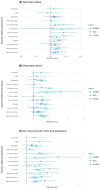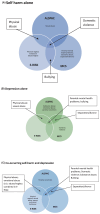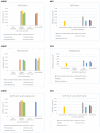The relationship between type, timing and duration of exposure to adverse childhood experiences and adolescent self-harm and depression: findings from three UK prospective population-based cohorts
- PMID: 38613494
- PMCID: PMC7616850
- DOI: 10.1111/jcpp.13986
The relationship between type, timing and duration of exposure to adverse childhood experiences and adolescent self-harm and depression: findings from three UK prospective population-based cohorts
Abstract
Background: Adverse childhood experiences (ACEs) are well-established risk factors for self-harm and depression. However, despite their high comorbidity, there has been little focus on the impact of developmental timing and the duration of exposure to ACEs on co-occurring self-harm and depression.
Methods: Data were utilised from over 22,000 children and adolescents participating in three UK cohorts, followed up longitudinally for 14-18 years: the Avon Longitudinal Study of Parents and Children (ALSPAC), the Millennium Cohort Study (MCS) and the Environmental Risk (E-Risk) Longitudinal Twin Study. Multinomial logistic regression models estimated associations between each ACE type and a four-category outcome: no self-harm or depression, self-harm alone, depression alone and self-harm with co-occurring depression. A structured life course modelling approach was used to examine whether the accumulation (duration) of exposure to each ACE, or a critical period (timing of ACEs) had the strongest effects on self-harm and depression in adolescence.
Results: The majority of ACEs were associated with co-occurring self-harm and depression, with consistent findings across cohorts. The importance of timing and duration of ACEs differed across ACEs and across cohorts. For parental mental health problems, longer duration of exposure was strongly associated with co-occurring self-harm and depression in both ALSPAC (adjusted OR: 1.18, 95% CI: 1.10-1.25) and MCS (1.18, 1.11-1.26) cohorts. For other ACEs in ALSPAC, exposure in middle childhood was most strongly associated with co-occurring self-harm and depression, and ACE occurrence in early childhood and adolescence was more important in the MCS.
Conclusions: Efforts to mitigate the impact of ACEs should start in early life with continued support throughout childhood, to prevent long-term exposure to ACEs contributing to risk of self-harm and depression in adolescence.
Keywords: ALSPAC; Adverse childhood experiences; E‐Risk; MCS; accumulation of risk; cohort; depression; developmental timing; self‐harm.
© 2024 The Authors. Journal of Child Psychology and Psychiatry published by John Wiley & Sons Ltd on behalf of Association for Child and Adolescent Mental Health.
Conflict of interest statement
Conflict of interest statement: No conflicts declared.
Figures




References
-
- Aaltonen KI, Isometsa E, Sund R, Pirkola S. Risk factors for suicide in depression in Finland: First-hospitalized patients followed up to 24 years. Acta Psychiatrica Scandinavica. 2019;139:154–163. - PubMed
-
- Asmussen K, Fischer F, Drayton E, McBride T. Adverse childhood experiences: What we know, what we don’t know, and what should happen next. London: 2020.
-
- Baldwin JR, Arseneault L, Caspi A, Moffitt TE, Fisher HL, Odgers CL, et al. Danese A. Adolescent victimization and self-injurious thoughts and behaviors: A genetically sensitive cohort study. Journal of the American Academy of Child & Adolescent Psychiatry. 2019;58:506–513. doi: 10.1016/j.jaac.2018.07.903. - DOI - PMC - PubMed
MeSH terms
Grants and funding
- 217065/Z/19/Z/WT_/Wellcome Trust/United Kingdom
- ES/S012567/1/Economic and Social Research Council (ESRC)
- NIHR300591/National Institute for Health and Care Research
- G0701594/MRC_/Medical Research Council/United Kingdom
- R01 HD077482/HD/NICHD NIH HHS/United States
- NIHR300591/DH_/Department of Health/United Kingdom
- MR/N0137941/1/MRC_/Medical Research Council/United Kingdom
- 224114/WT_/Wellcome Trust/United Kingdom
- GR067797MA/WT_/Wellcome Trust/United Kingdom
- Jacobs Foundation
- MC_UU_12013/2/MRC_/Medical Research Council/United Kingdom
- 224114/Z/21/Z/WT_/Wellcome Trust/United Kingdom
- 092731/WT_/Wellcome Trust/United Kingdom
- PD301198-SC101645/National Institute for Health and Care Research
- 215917/Z/19/Z/WT_/Wellcome Trust/United Kingdom
- MR/X010791/1/MRC_/Medical Research Council/United Kingdom
- 215917/WT_/Wellcome Trust/United Kingdom
- 092731/Z/10/Z/WT_/Wellcome Trust/United Kingdom
- MRF-058-0017-F-MARS-C0869/MRF/MRF/United Kingdom
- 217065/WT_/Wellcome Trust/United Kingdom
- G1002190/MRC_/Medical Research Council/United Kingdom
- HD077482/National Institute of Child Health and Human Development
- G0701594/WT_/Wellcome Trust/United Kingdom
LinkOut - more resources
Full Text Sources
Medical
Miscellaneous

